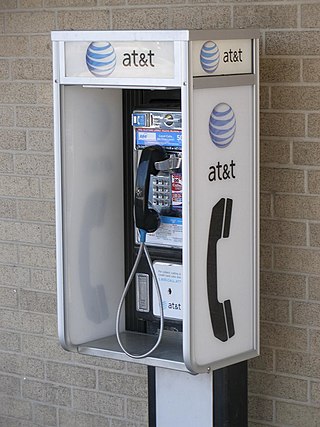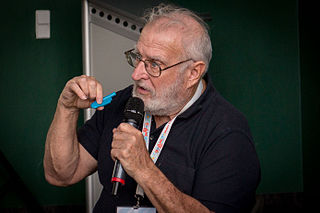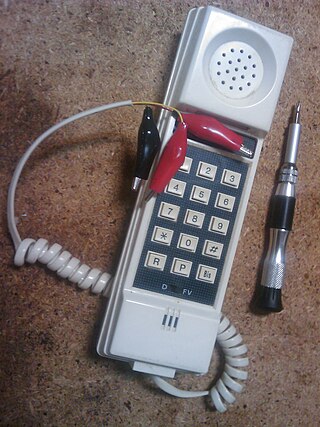
In telecommunications, an acoustic coupler is an interface device for coupling electrical signals by acoustical means—usually into and out of a telephone.
Phreaking is a slang term coined to describe the activity of a culture of people who study, experiment with, or explore telecommunication systems, such as equipment and systems connected to public telephone networks. The term phreak is a sensational spelling of the word freak with the ph- from phone, and may also refer to the use of various audio frequencies to manipulate a phone system. Phreak, phreaker, or phone phreak are names used for and by individuals who participate in phreaking.

A payphone is typically a coin-operated public telephone, often located in a telephone booth or in high-traffic public areas. Prepayment is required by inserting coins or telephone tokens, swiping a credit or debit card, or using a telephone card.

A blue box is an electronic device that produces tones used to generate the in-band signaling tones formerly used within the North American long-distance telephone network to send line status and called number information over voice circuits. During that period, charges associated with long-distance calling were commonplace and could be significant, depending on the time, duration and destination of the call. A blue box device allowed for circumventing these charges by enabling an illicit user, referred to as a "phreaker," to place long-distance calls, without using the network's user facilities, that would be billed to another number or dismissed entirely by the telecom company's billing system as an incomplete call. A number of similar "color boxes" were also created to control other aspects of the phone network.

John Thomas Draper, also known as Captain Crunch, Crunch, or Crunchman, is an American computer programmer and former phone phreak. He is a widely known figure within the computer programming world and the hacker and security community, and generally lives a nomadic lifestyle.

A silver box is a modified DTMF keypad that adds four additional keys. This gives four columns of four keys each instead of three columns.

A telephone call or telephone conversation, also known as a phone call or voice call, is a connection over a telephone network between the called party and the calling party. Telephone calls started in the late 19th century. As technology has improved, a majority of telephone calls are made over a cellular network through mobile phones or over the internet with Voice over IP. Telephone calls are typically used for real-time conversation between two or more parties, especially when the parties cannot meet in person.
In telephony, multi-frequency signaling (MF) is a type of signaling that was introduced by the Bell System after World War II. It uses a combination of audible tones for address transport and supervision signaling on trunk lines between central offices. The signaling is sent in-band over the same channel as the bearer channel used for voice traffic.
Phone fraud, or more generally communications fraud, is the use of telecommunications products or services with the intention of illegally acquiring money from, or failing to pay, a telecommunication company or its customers.
A clear box is an amplifier used by phreaks to use post-pay pay phones without paying. In some locations, especially rural areas in the United States and Canada, pay phones were configured for "post-pay" operation. In this mode, the handset microphone is muted until payment is made. The user of a post-pay pay phone would dial first, wait until the called party answered, and at that point the user would be prompted to insert the coins. Upon receiving the correct payment for the call, the pay phone would then connect the microphone and allow the caller to speak. An artifact of this scheme was that the called party usually heard the ACTS tones produced by the pay phone upon coin deposit.

In phone phreaking, a beige box is a device that is technically equivalent to a telephone company lineman's handset — a telephone fitted with alligator clips to attach it to a line.
2600 hertz (2600 Hz) is a frequency in hertz that was used in telecommunication signaling in mid-20th century long-distance telephone networks using carrier systems.

On analog telephone lines with special services, a flash or register-recall signal is used to control functions on the public telephone exchange, PBX or VoIP ATA.
A vermilion box is a (hypothetical) portable telephone line emulator used for phreaking, whose function is to spoof all of the aspects of an incoming phone call—DC line voltage, an AC ringing signal and caller ID—while the line is disconnected from the public switched telephone network (PSTN), as well as allow the user to communicate with the recipient if the call is answered. Its use requires a physical connection to the circuit somewhere between the target premises and the exchange, but when properly applied, results in a stealth-intensive incoming call that appears completely genuine but which cannot be electronically traced. Typically, the user physically disconnects the target line from the network or causes an outage in the system, connects the vermilion box, and then initiates the illicit call.
A phreaking box is a device used by phone phreaks to perform various functions normally reserved for operators and other telephone company employees.
The off-hook tone is a telephony signal for alerting a user that the telephone has been left off-hook without use for an extended period, effectively disabling the telephone line.

Novation, Inc., is an early modem manufacturer whose CAT series were popular in the early home computer market in the late 1970s and early 1980s, notably on the Apple II. The Hayes Smartmodem 300, introduced in 1981, helped kill off Novation and many other early modem companies over the next few years.
The Signaling System No. 5 (SS5) is a multi-frequency (MF) telephone signaling system that was in use from the 1970s for International Direct Distance Dialing (IDDD). Internationally it became known as CCITT5 or CC5. It was also nicknamed Atlantic Code because it was used for the first IDDD connections between Europe and North America.
In Phreaking, the green box was a device whose function was to manipulate the coin collection mechanism of payphones. It employed three of the MF (multi-frequency) tones used in the blue box and could be viewed as a subset of that device.
Ringing is a telecommunication signal that causes a bell or other device to alert a telephone subscriber to an incoming telephone call. Historically, this entailed sending a high-voltage alternating current over the telephone line to a customer station which contained an electromagnetic bell. It is therefore also commonly referred to as power ringing, to distinguish it from another signal, audible ringing, or ringing tone, which is sent to the originating caller to indicate that the destination telephone is in fact ringing.








